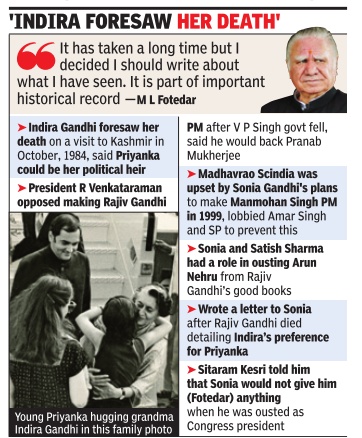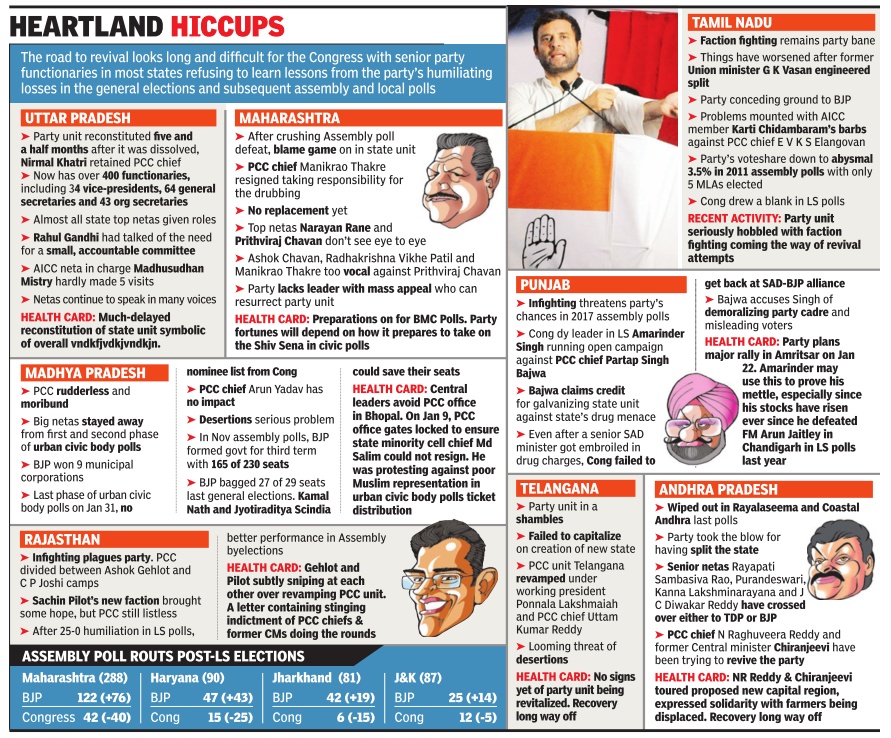Indian National Congress
This is a collection of articles archived for the excellence of their content. |
1984: Mrs Gandhi has premonition about her death
The Times of India, Oct 20 2015

`Scindia lobbied Amar Singh against backing Cong bid to form govt in 1999'
Indira Gandhi had a premonition about her death just days before she was assassinated and con fided to her close associate M L Fotedar that she saw the possibility of Priyanka Gandhi eme rging as her political legatee over time -a suggestion that did not seem to go down well with Sonia Gandhi. Revealing the dramatic circumstances of Indira's last days, Fotedar said she had visited Kashmir in late October 1984, drawn by a fondness of the change of season scenery and a desire to visit a Hindu and a Muslim shrine that the late leader reposed particular faith in. She was assassinated in Delhi on October 31, 1984. The old time Gandhi loy alist's recollection are due to be made pub lic soon in the form of a book `Chinar Leaves' that will be released on October 30 in the capital. Fotedar seems to support former minister Natwar Singh's claim that family pressure rather than an “inner voice“ was the reason for Sonia declining the prime minister's post in 2004. “She saw a sign at the Hindu shrine that made her feel that her life was coming to an end. On the way back to the rest house in a car, she said as much. Then, in a thoughtful mood, she said Priyanka might be cut out for politics...that she might be successful and be in power for a long time,“ Fotedar. The “sign“ Indira saw and which she interpreted to mean impending death was a shriveled tree at the Hindu shrine. Fotedar said he too read a similar portent. “I think she realised that I had noticed it too and reached similar conclusions. She revealed her mind on the way to the rest house,“ Fotedar said. Much later, Fotedar wrote a detailed letter to Sonia putting down Indira's thoughts on Priyanka after the assassination of Rajiv Gandhi in 1991 during campaigning for the Lok Sabha election. Apparently , the contents of the letter were not well received.“I did write to Sonia describing whatever transpired on hat visit to Kashmir,“ Fote dar said.
1999: Scindia lobbied Amar against backing Cong’s govt. bid
The Times of India Fotedar said the late Madhavrao Scindia lobbied ormer Samajwadi Party eader Amar Singh against supporting the Congress's claim to forming a govern ment in 1999 after the Vaj payee government lost a con idence motion by one vote Scindia, according to Fote dar, was miffed at the possi bility of Sonia nominating Manmohan Singh as the prime minister and worked to prevent such an eventuality . While Fotedar's account has the Manmohan Singh angle, the accounts of the period have Sonia as having made the claim to have the support of 272 MPs to the then President K R Narayanan. Fotedar's revelations indicate a cooling of relations between him and Sonia as he wryly recalled the late Congress leader Sitaram Kesri warning him that he will get nothing from the current Congress president. “Yes, that happened. We used to talk very freely . It was my job to tell him that he had to make way for Sonia. He was upset and said I would get nothing for all my troubles,“ Fotedar said. Kesri's prophesy seems to have come true to a large extent as Fotedar was passed over for even a Rajya Sabha membership while other members of the Congress (T) -the splinter formed by Sonia loyalists to oppose P V Narasimha Rao -like Arjun Singh, N D Tiwari and Sheila Dikshit, did much better. Fotedar recalled that he felt Rajiv Gandhi's rift with his cousin Arun Nehru was handled badly and suggests that Sonia and Satish Sharma had a role in Nehru's ouster. “I did tell Rajiv that the episode could rebound on him as Arun Nehru would seek revenge. That is what happened when the Bofors story surfaced,“ he said.
The veteran also said that after the V P Singh government fell in 1990, the then President R Venkataraman was dead opposed to swearing in Rajiv Gandhi as prime minister, preferring Pranab Mukherjee instead. Rajiv was taken aback by Venkataraman's vehemence.
2003-14:fluctuating fortunes
Jan 19 2015
The Grand old party struggles to find a revival strategy amid infighting, inertia & confusion
As Congress prepares to launch an ambitious membership drive to start a resolute fight against the Modi government’s policies, a status report of its major state units shows the Grand Old Party must first defeat its enemies within: Chronic factionalism, inertia and confusion over organizational matters. Eight months after its rout in the LS elections, factional bickering and inaction remain its biggest weaknesses in most major states. In fact, these caused the party further humiliating losses in subsequent assembly and local body polls in many of these states.
Rahul Gandhi’s plans to reorganize the party have run into stubborn resistance from senior leaders in states such as UP, Rajasthan and Punjab.
And there seems to be little effort to address the malaise of a communication gap — one of Congress’s weakest spots in the LS poll campaign. Embarrassingly for Rahul, Sonia Gandhi’s office overruled his restructuring plans for the UP unit and cleared a mammoth 402-member executive on Tuesday. This, despite his insistence on small and accountable state executives. He’d rejected the UP PCC’s proposal before the CWC meet, asking it to prune the members to 250.
Possibly to address factionalism, the leadership adopted a ‘keep-everybody-happy’ approach, ignoring the cap on state-executive size Rahul favoured. This went against Rahul’s plan to reform the Congress machinery. The new in-charge of UP Congress’s communication unit, VN Madan, justified the jumbo executive. “UP is a very large state. For the party’s revival, we needed an all-inclusive group spanning all castes and religions,” he told TOI.
Elsewhere, it’s not just Rahul’s organizational overhaul plan that’s run into resistance. His appointees face rough weather, rivals blocking efforts to revive the organization. This is most evident in Punjab, where his handpicked chief Partap Singh Bajwa is locked in intense battle with Amarinder Singh, the party’s deputy leader in the LS. So much so, they’ve announced separate rallies against the Badal government on January 22.
Singh wants charge of PCC.
He’s reportedly told Sonia that under Bajwa, Congress victory against the SAD-BJP combine in the 2017 assembly polls would be difficult to achieve.
Singh hosted a luncheon show of strength in Patiala, where he claimed support of 35 of Congress’s 44 MLAs. Bajwa hit back in an interview to Eco nomic Times, saying: “There’s no need for a separate rally.
That’ll confuse supporters and demoralize workers.” Like Bajwa, another Rahul appointee, Rajasthan party chief Sachin Pilot too is on a difficult pitch. The party here is divided between Pilot followers and those of former CM Ashok Gehlot. Congress’s LS poll disaster was mirrored in the recent municipal polls.
Gehlot locked himself in his hometown, Jodhpur. Sources said the leaders hardly worked together during the campaign.
It looks grim for the party in the ongoing panchayat polls.
Rejecting Pilot’s restructuring plan, Gehlot said: “Those who left out should be inducted because when the party is not in power, responsibility to keep everyone together increases.” Pilot retorted: “We’ve appointed a large enough PCC.” Congress units in most states seem to have learnt no lessons despite many attributing the party’s successive assembly poll routs to factionalism. Only last week, Maharashtra’s ex-CM Ashok Chavan complained that internal differences had proved fatal in the assembly polls. “Groupism needs to be curtailed,” he cautioned. The problem of faction fighting in Maharashtra now looms large over the Brihan mumbai Muncipal Corporation elections. Congress looks clueless on tackling the Shiv Sena challenge. The party’s central leadership is still to decide on a replacement for Manikrao Thakre who quit as state chief in October taking responsibility for the assembly polls rout. The anti-Prithviraj Chavan lobby, in the forefront before the state polls, remains just as active.
Elsewhere, party units look listless. Indecision and inertia are common in the MP, TN, Andhra and Telangana units.
Take MP. The PCC’s indecision gave BJP a cakewalk in the first and second phases of the civic elections. The ruling party won all nine corporations. Even for the January 31 phase, Congress has missed the deadline for filing nominations. PCC chief Arun Yadav remained virtually incommunicado during this period and repeated AICC attempts to contact him failed.
The TN, Telangana and AP units are in disarray. In AP and Telangana, Congress continues to lie low months after defeats in both states. In AP, last week leaders N Raghuveera Reddy and Chiranjeevi emerged in public when they toured the new capital region near Vijaywada, expressing solidarity with farmers facing displacement. Privately , AP Congress netas say the road to recovery is long and arduous, and repair work could stretch till 2019. The scene is no dif ferent in Telangana. There’s virtually no activity at party headquarters Gandhi Bhavan.
TN Congressmen seem to have learned no lessons even after former Union minister G K Vasan split the party in November. Karti Chidambaram, P Chidambaram's son, challenged new party chief EVKS Elangovan rubbishing his efforts to revive the party invok ing Congress icon K Kamraj, known for his corruption-free administration in the 1960s.
“How will a 21-year-old connect to Kamaraj rule,” asks Karti, stressing that develop ment and employment are bigger issues.
